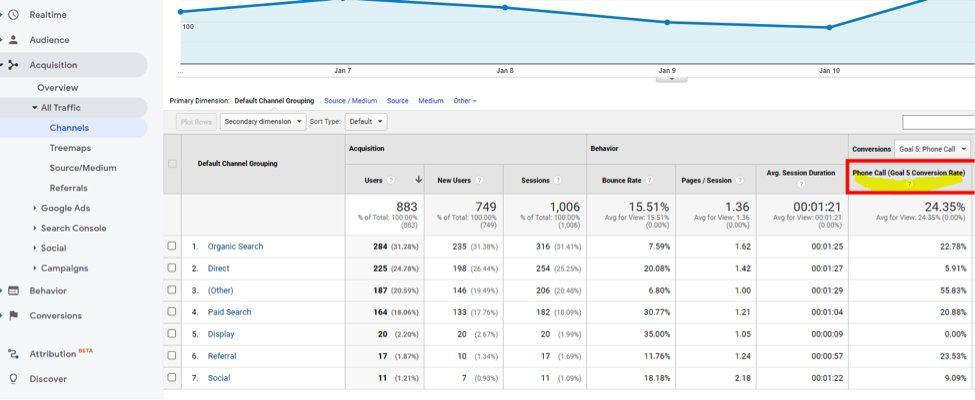Interested in Business?
Get Business articles, news and videos right in your inbox! Sign up now.
Business + Get AlertsA lot changed in 2020. But one of the things that remained constant is the need for a well-optimized, high-converting website.
How does your website measure up?
While you might leave a lot of that to your marketing partner, it’s good to know how to check website conversions and what could impact or influence them. Here’s a quick guide.
How to Check Website Conversion Stats
Assuming you have goals set up in Google Analytics, you can check conversion rates by heading to analytics.google.com and logging into an account that has access.
Once logged in, there are several ways to check conversion rates. But one of the simplest ways is to click on Acquisition > All Traffic > Channels on the left-hand side of the dashboard.
Once there, you should see conversion rates for the goals you have set up, like in the screenshot below:
What Factors Could Impact Conversions?
If conversions have dropped or you are getting a lot of site traffic but few conversions, it’s time to do some sleuthing. While there are a lot of factors that can impact conversion rates, here are some of the first things you should check:
#1 User Experience Factors
You could drain your ads budget and still have a low converting site if you provide a poor user experience. How your customers and potential customers feel on your site matters, and there are a lot of factors that influence how they’ll feel on your site. How they feel influences whether they stick around to learn more or hit the back button and leave.
Here are some of the website factors that can influence experience:
- Page structure: Is everything laid out in a pleasing way? Is the most important content easy to find? If your site is overwhelming, messy, or illogically structured, it will frustrate searchers and they’ll leave.
- Text, photos & videos: Are you using a nice mix of text, photos, and videos? Is all of your content original, thorough, and high-quality? If you sound and look like everyone else, say what everyone else says, and use the same stock photos everyone else uses, your potential client will keep looking.
- Header tags: Are your header tags clear? Are they frequently used and descriptive? Can visitors use them to quickly scan for the most relevant information? We’re all in a hurry, so make it easy for site visitors to find what they need or they’ll get frustrated.
- Internal linking: Are you linking to other pages on your site so that if visitors want to learn more or learn about a related topic, they can easily find that content? Are you making it easy to navigate your site? If you don’t, they may end up going to another site that provides better, more thorough, and more easily found answers and solutions.
- Chat widget use and visibility: If visitors want to reach out to someone for immediate assistance, are they able to? Is your chat widget user-friendly, responsive, and helpful? Is it easy to find on your website? All of these things matter. If you can’t provide a good chat widget experience, don’t have one.
- Visibility of phone number and ease of contact: Can site visitors quickly find your contact info? Do you provide more than one method of contact? If it’s not easy to contact you, people won’t do it.
- CTAs (Call to Action): Is it clear what the next steps are for those interested in your services? Are your CTAs clear, frequent, singularly-focused, and easy to interact with on desktop and mobile? One of the simplest ways to increase conversions is to tell people what they need to do and how they can do it.
- Mobile friendliness: Just because we’re all stuck at home doesn’t mean we’re all searching on laptops and desktops. Make sure your website is easy to navigate and looks good on mobile. If it doesn’t, people aren’t going to get off the couch to grab their laptop. They’re going to find another company with a better website. Take a look at your website on as many devices as you can.
- Load time: You could have the best videos, content, and photos in the world. You could have the best looking site in the world. But if it takes forever to load, no one’s going to stick around to see it. So check your site load time and do everything you can to get it under 3 seconds.
#2 Content & Design
How does your site look? Like something pre-Y2K?
If so, it’s not going to convert for two reasons:
- People won’t trust it.
- It won’t be easy to use and navigate.
As a reflection of your business, if your site looks low-quality and unprofessional, it will communicate that you provide a low-quality, unprofessional experience to clients. So make sure your design is clean, on brand, and speaks to the level of professionalism that you provide.
That said, don’t ever put design over usability. Make sure there’s plenty of white space so that buttons and CTAs are easy to click. Otherwise, visitors will get frustrated.
Now, let’s talk content.
When people land on your website, they want to be able to quickly find helpful information that tells them what problems you solve, how you solve them, and why they should trust you. In order to do that, your content needs to answer their questions, work to build trust, remove perceived risk, and address their problems and concerns.
Don’t be vague and don’t copy and paste someone else’s content. Introduce your company and let potential clients know what they can expect if they work with you. Make it easy for them to see how you’re different and why you’re the company they can trust to solve their problems.
Make it easy for them to scan and find what matters most to them. And always put the most important content at the top of the page, when possible.
#3 Trust Factors
Unless a site visitor has total confidence that you’re the company to call before they even land on your website, they’re going to be looking for trust factors for validation and social proof that you’re the right choice. Make sure they find it. Include testimonials, reviews, and any certifications or memberships that might work to build trust.
We may make decisions based on emotions, but we justify those decisions with logic. Confirm you’re the right choice by showing them that others choose you, you’ve solved problems like theirs for people like them, and you know your stuff.
But Before You Make Changes …
If your conversion rates aren’t where you want them to be, it’s always a good idea to talk with your marketing partner before making any changes yourself. They may have reasons for doing things a specific way.
Talk to them about some of the factors discussed in this article and some of your findings. They should be able to tweak and optimize your website for conversions, and they should also know what else might need to be checked.
About the Authors
Carter Harkins and Taylor Hill are the co-founders of Spark Marketer, a Nashville, Tennessee-based digital marketing company that works primarily with service businesses. They're also co-creators of the award-winning app Closing Commander, which helps contractors close more estimates effortlessly, and co-authors of the book, Blue Collar Proud: 10 Principles for Building a Kickass Business You Love. Both regularly speak at service industry trade shows and conferences across the nation. Visit www.sparkmarketer.com, www.about.closingcommander.com, www.facebook.com/sparkmarketer, or www.facebook.com/closingcommander.







